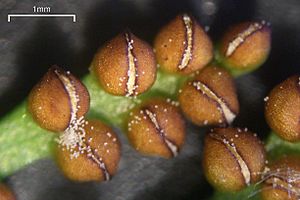Northwestern moonwort facts for kids
Quick facts for kids Northwestern moonwort |
|
|---|---|
 |
|
| Sporulation | |
| Conservation status | |
| Scientific classification | |
| Genus: |
Botrychium
|
| Species: |
pinnatum
|
The northwestern moonwort (scientific name: Botrychium pinnatum) is a special type of fern. It belongs to a plant family called Ophioglossaceae. This small fern is known for its unique leaf shape, which looks a bit like a moon, giving it its common name.
Contents
Where Does the Moonwort Live?
This interesting fern grows across a wide area in North America. You can find it from Alaska all the way down to California and Arizona. It also lives in northern Canada and even in Greenland.
Its Favorite Places
The northwestern moonwort likes to grow in specific environments. It often lives in coniferous forests, which are forests filled with cone-bearing trees like pines and firs. You can also spot it in open, grassy meadows. Even though it covers a large area, this fern is usually scattered and not very common in most places.
What Does the Moonwort Look Like?
This fern is quite small, often hard to spot! It grows from a part of the plant that stays underground, called a caudex. From this underground base, just one thin, shiny, green leaf pops up above the ground.
The Moonwort's Unique Leaf
The single leaf of the northwestern moonwort is usually less than 8 centimeters (about 3 inches) tall. What's really cool about this leaf is that it's divided into two main parts:
- Sterile part: This is the flat part of the leaf. It has small sections called leaflets that are shaped like ovals or wide spearheads. This part of the leaf is responsible for making food for the plant using sunlight.
- Fertile part: This part of the leaf looks very different! Instead of flat leaflets, it has clusters that look a bit like tiny grapes. These clusters are actually sporangia.
How Does the Moonwort Reproduce?
The fertile part of the leaf is super important because it's where the fern reproduces. The grapelike clusters, or sporangia, contain tiny spores. When these spores are ready, they are released and can grow into new moonwort plants if they land in a good spot. This is how the northwestern moonwort makes new ferns and continues its life cycle.


